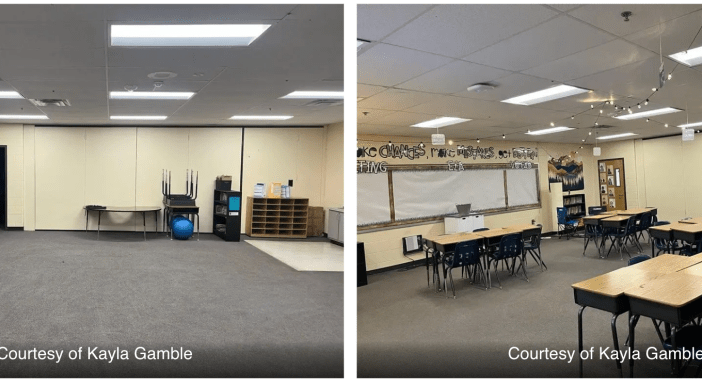From pencils and notebooks to tables and chairs, low-paid teachers are shelling out big bucks for necessities their schools won’t provide.
by Maya Pottiger August 21, 2023
Word In Black
maya.pottiger@localmedia.org
When she graduated from college, Kayla Gamble had a typical request: Money.
But Gamble, who had just earned her teaching degree, wasn’t putting the money toward a well-deserved trip or new apartment furniture or even saving it for bills. Instead, she needed it to fund her classroom.
“You’re starting from scratch,” Gamble, a fourth-grade teacher in the Atlanta area, says.
She started out putting the funds toward the “bare necessities,” like storage and other bigger items she’ll need year after year. But, she says, “that money goes away pretty quickly.”
“I slowly stocked up, even trying to be creative and using, basically, colored paper to decorate my room,” Gamble says. “I wasn’t necessarily going super hard trying to be like the Pinterest or Instagram teachers. I’m not spending all of my money.”
What Teachers Are Buying
So what are teachers buying for their classrooms?
For Gamble, it’s “basically everything that you see:” Tables and chairs, flexible seating (cushions and soft surfaces), and even basics like pencils, glue sticks, and cleaning supplies. Gamble says she’s spent at least $200 on Clorox wipes.
This holds up with the experience of teachers nationwide. The most common request among teachers is basic classroom supplies, according to a 2023 DonorsChoose survey. This means things like paper, pencils, and cleaning supplies. They also request things that address students’ basic needs: Personal items like snacks, warm clothing, and hygiene products.
Teachers were least likely to report needing technology.
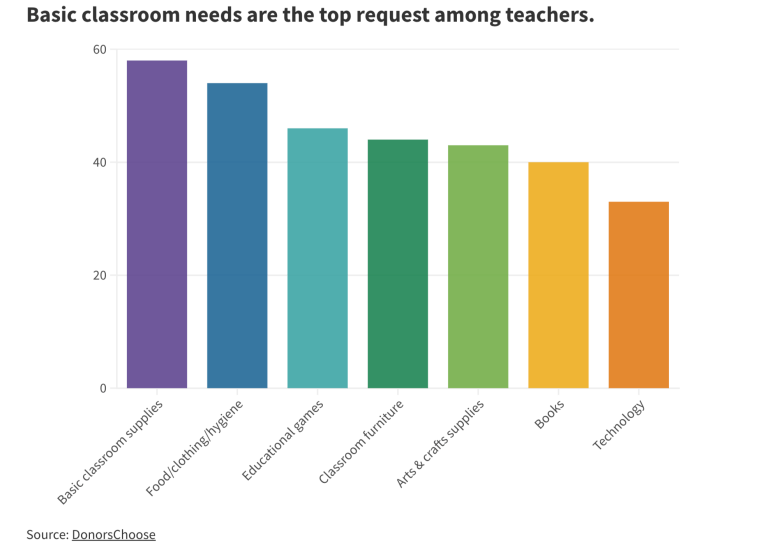
And, though she asks for parents to help out, Gamble works in a Title I school, which means low-income students are at least 40% of the enrollment. “Parents are more working class, so it’s a little bit harder to get them to participate, especially donating,” she says.
Kandice Taylor, an eighth-grade science teacher in Jackson, Mississippi, also works at a Title I school, but she has a different shopping list.
Every year, Taylor has to not only purchase new lab materials with a limited shelf life, like chemicals and food materials, but also replace easily broken supplies, like ramekin cups.
Not only does Taylor purchase all of the lab supplies her students need, she’s also had to buy tables and chairs for her classroom. Her school only provided desks for her classroom, “and I do not feel that you can do science in a desk,” Taylor says.
“Science is not something that you can do with pencil and paper, and that’s how they expect you to teach it,” Taylor says. “But that’s not the type of teacher that I am. And that’s not how you can actually learn.”
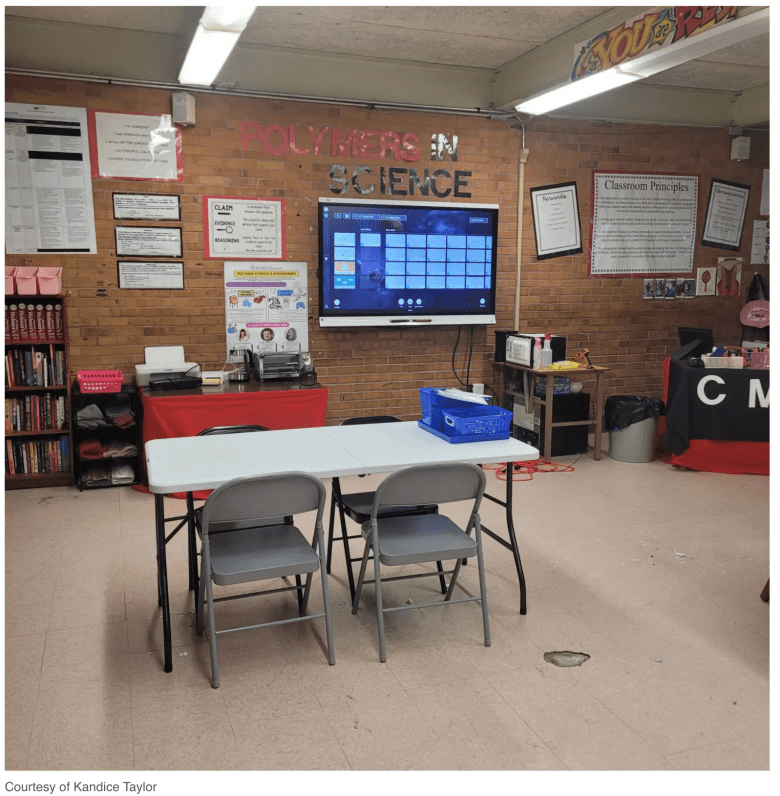
Teachers Annually Spend Hundreds on Classroom Supplies
On average, teachers spend $687 of their pocket money on classroom supplies, and the number rises to $714 for teachers of color, according to the DonorsChoose survey. And, the survey found, teachers are spending more post-pandemic.
But Gamble and Taylor have far exceeded that heading into the 2023-2024 school year.
Though Gamble has gotten lucky this year with internet-goers purchasing between $1,000-$2,000 worth of items off her wishlist, she’s still spent money on snacks and smaller things. And Taylor has already spent $4,200 before school even started — far exceeding her usual $3,000 due to needing to replace larger classroom items.
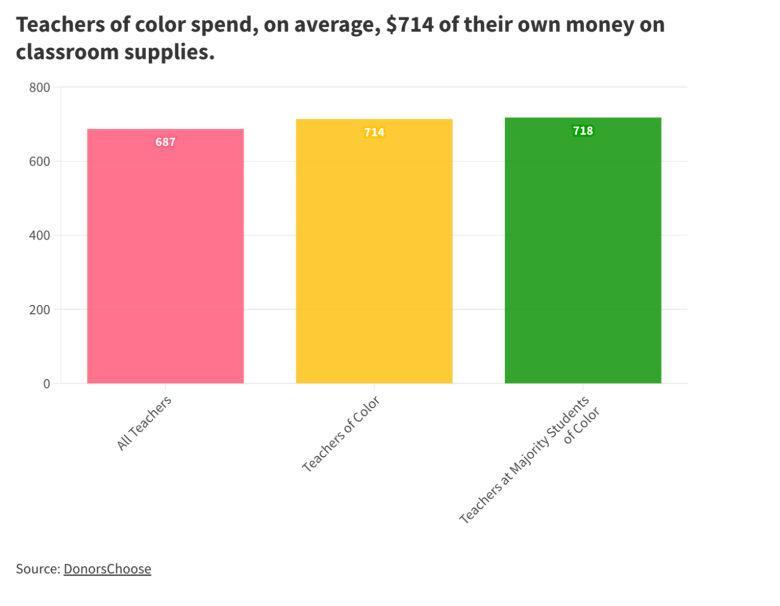
In terms of items on Gamble’s wishlist, people are helping out by buying necessities, like extra paper and composition notebooks.
“All those things just add up and eat away at our salary,” Gamble says.
‘We’re Just Doing Our Best to Make Sure Every Kid Has Enough’
When it comes to out-of-pocket spending, it’s about “how truly committed you are to a child’s education,” Taylor says.
For Taylor, it’s important to get the materials to help with a student’s critical thinking, help facilitate learning with them, and help them be accountable for their own learning.
“I believe in giving a child my best,” Taylor says. “So it’s not unusual , but it’s not a typical thing, either.”
Teachers try to do memorable things throughout the year and make sure kids feel special and seen. One of the ways Gamble shows her students she cares is by putting together birthday bags, which are filled with candies, fidget toys, and other things she knows they like.
“A lot of my kids, their parents are immigrants, they’re working class. A lot of them don’t do a lot for their birthday,” Gamble says. “They come into class in the morning, and they have a cute little bag just for them. I feel like it’s the least I can do.”
“We’re just trying to do our best with what we have,” Gamble says, “and to make sure that every kid has enough.”
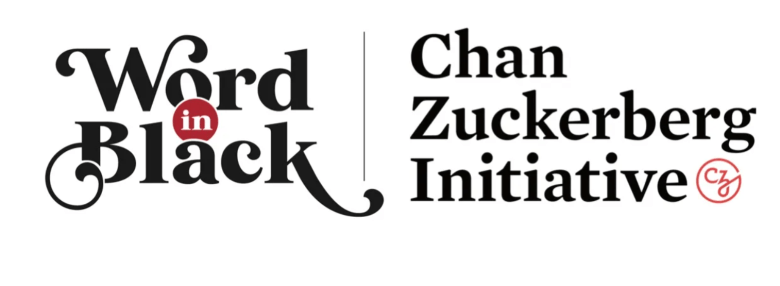
Get Word In Black directly in your inbox. Subscribe today.
